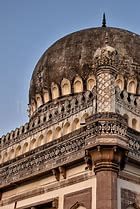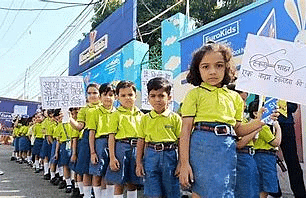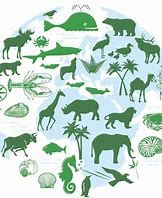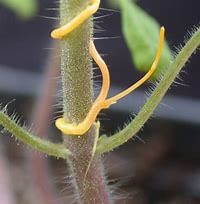UPSC Daily Current Affairs- 14th February 2024 | Current Affairs & Hindu Analysis: Daily, Weekly & Monthly PDF Download
GS-I
Mohammed Quli Qutb Shah’s Tomb
Subject: Art and Culture

Why in News?
A digital twin of the Mohammed Quli Qutb Shah’s tomb was unveiled by a reality technology company, Hexagon in Hyderabad.
Who was Mohammed Quli Qutb Shah?
- Parentage: Muhammad Quli Qutb Shah was born on April 4, 1565, as the third son of Ibrahim Quli Qutb Shah Wali and his Hindu mother Bhagirathi.
- Literary Talent: He was not only an able administrator but also a skilled poet who composed verses in Persian, Telugu, and Urdu.
Key Accomplishments
[A] Reign and Accomplishments
- Ascension to the Throne: Muhammad Quli succeeded his father in 1580 at the age of 15 and ruled for 31 years.
- Military Campaigns: Despite facing rebellions, he effectively led troops and quelled disturbances, ensuring stability in his realm.
[B] Foundation of Hyderabad
- Urban Planning: Concerned about overcrowding in Golkonda, Muhammad Quli initiated the construction of Hyderabad in 1591.
- Land Selection: While folklore suggests a romanticized version of land selection, Muhammad Quli’s vision for Hyderabad’s development aimed at relieving congestion and promoting growth.
[C] Architectural Marvels and City Planning
- Charminar: As the architectural centrepiece, Charminar was built under Muhammad Quli’s patronage, symbolizing the city’s grandeur.
- City Layout: Hyderabad was meticulously planned with a gridiron layout, featuring significant landmarks like Darulshafa, Mecca Masjid, and Badshahi Ashurkhana.
[D] Support for Arts and Literature
- Calligraphic Art: Under Muhammad Quli’s rule, calligraphy flourished, with various scripts adorning buildings such as the Mecca Masjid.
- Literary Contributions: Muhammad Quli’s poetic works in Urdu and Dakhni languages reflected his diverse interests and cultural appreciation.
- Taraqqi: He was a poet himself and composed poetry in Persian and Telugu under the pen name “Taraqqi”.
[E] Medical and Literary Contributions
- Intellectual Hub: Hyderabad became a centre for medical and literary pursuits, with scholars producing notable works during Muhammad Quli’s reign.
- Preservation of Culture: Muhammad Quli’s literary legacy, including his Diwan, is preserved in institutions like the Salar Jung Museum, showcasing his contribution to cultural heritage.
Legacy and Influence
- Cultural Integration: Muhammad Quli’s reign represents a period of cultural fusion, blending Hindu and Islamic traditions in the Deccan region.
- Symbol of Unity: His efforts to promote harmony and coexistence endure as a testament to the inclusive ethos of his administration.
Source: Times of India
GS-II
PM Surya Ghar Muft Bijli Yojana
Subject: Government Schemes

Why in News?
Prime Minister of India launched PM Surya Ghar Muft Bijli Yojana to provide free electricity to its beneficiaries.
About PM Surya Ghar Muft Bijli Yojana:
- In this scheme, the central government will provide 300 units of free electricity per month to its beneficiaries by investing worth ₹75,000 crores.
- The free electricity scheme was earlier announced by the Finance Minister in an interim budget speech.
- Target: It aims to light up 1 crore households.
- Under the scheme, Urban Local Bodies and Panchayats shall be incentivised to promote rooftop solar systems in their jurisdictions.
- The Central Government will guarantee no financial burden on the people by providing significant subsidies directly to their bank accounts and offering highly concessional bank loans.
- Expected benefits:
- Savings of up to fifteen to eighteen thousand rupees annually for households from free solar electricity and selling the surplus to the distribution companies;
- Charging of electric vehicles;
- Entrepreneurship opportunities for a large number of vendors for supply and installation;
- Employment opportunities for the youth with technical skills in manufacturing, installation and maintenance.
Source: Live Mint
APAAR: One Nation, One Student ID Initiative
Subject: Polity and Governance

Why in News?
What is APAAR?About 25 crore Automated Permanent Academic Account Registry (APAAR) have been created, Union Education Minister informed at a national conference on ‘APAAR: One Nation One Student ID Card.’
- What is it? : APAAR serves as a unique identification system for all students across India, commencing from early childhood.
- Lifelong Student ID: Every student is assigned a lifelong 12-digit ID, simplifying the tracking of academic progress from pre-primary education through higher education.
- Gateway to Digilocker: APAAR functions as a gateway to Digilocker, a digital repository where students can securely store crucial documents, including exam results and report cards, for convenient access during future endeavours such as higher education or job applications.
- Unique Identification: Each individual receives a unique APAAR ID, linked to the Academic Bank Credit (ABC), a digital repository housing a student’s earned credits throughout their academic journey.
- Seamless Data Transfer: When students change schools, whether within the state or to another state, their data in the ABC is seamlessly transferred to the new school by sharing the APAAR ID, eliminating the need for physical document submission.
- All-Inclusive Repository: APAAR allows students to store certificates and credits from both formal and informal learning experiences, with digital certification from authorized institutions.
- Streamlined Education: APAAR’s introduction aims to streamline education processes, reducing the burden on students to carry physical documents.
- NEP 2020 Initiative: This initiative was launched as part of the National Education Policy 2020 by the Ministry of Education.
- Empowering State Governments: APAAR empowers state governments to monitor literacy rates, dropout rates, and educational improvements effectively.
- Combatting Fraud: It seeks to combat fraud and the proliferation of duplicate educational certificates by providing a single, reliable reference for educational institutions, ensuring authenticity through first-party verification.
- Registration Process: To enrol for APAAR, students provide basic details such as name, age, date of birth, gender, and a photograph, all of which are verified using their Aadhar number.
- Aadhar Authentication: The Aadhaar number is used solely for verification purposes to match the name and date of birth, with no sharing of this data during registration.
- Parental Consent for Minors: For minors, parental consent is mandatory for using the student’s Aadhar number for authentication with UIDAI.
- Voluntary Registration: Registration for creating an APAAR ID is voluntary, not mandatory.
- Data Security Concerns: Parents and students express concerns about sharing their Aadhar details, fearing potential leaks of personal information to external parties.
- Government Assurance: The government assures that shared information will remain confidential and will only be disclosed to entities engaged in educational activities, including UDISE+ (Unified District Information System for Education Plus), scholarships, academic record maintenance, educational institutions, and recruitment agencies.
- Data Control: Students retain the option to cease sharing their information with these entities at any time, with a halt in data processing. However, previously processed data remains unaffected if consent is withdrawn.
Source: India Today
NATO
Subject: International Relations

Why in News?
Former U.S President Donald Trump has criticised North Atlantic Treaty Organisation.
Background:
- As US president from 2017-21, Trump often lambasted NATO and members such as Germany, accusing them of not paying enough for their own defence and relying on Washington to protect them. Trump continues his criticism of NATO during campaign for upcoming presidential election.
About NATO:
- Founded in 1949 to counter the Soviet Union with Cold War tensions rising, the North Atlantic Treaty Organization is a political and military alliance of countries from North America and Europe.
- Enshrined in Article 5 of its founding treaty is the principle of collective defence – the idea that an attack on one member is considered an attack on all of them.
- However, Article 5 stops short of a commitment to an automatic military response to help an ally under attack. That means the strength of Article 5 depends on clear statements from political leaders that it will be backed up by action
- NATO takes decisions by consensus but the political and military strength of the United States means that it is by far the most powerful country in the alliance, with its nuclear arsenal seen as the ultimate security guarantee.
Which countries are in NATO?
- NATO currently has 31 members – most of them European nations, plus the United States and Canada.
- The newest member is Finland, which joined last April in reaction to Russia’s 2022 invasion of Ukraine.
- Sweden applied to join along with Finland but is waiting for Hungary to ratify its application as the final major step before membership.
- During the Cold War, NATO’s main focus was protecting Western Europe from the Soviet Union. After the 1989 fall of the Berlin Wall,NATO expanded to take in former communist bloc countries from Central and Eastern Europe.
- NATO’s members range from large countries such as Britain, France, Germany and Turkey to small nations such as Iceland and Montenegro.
How is NATO funded
- Trump has often accused other NATO members of not paying their dues, giving the impression that the alliance is like a club with membership fees.
- But NATO operates differently. It has some common funds, to which all members contribute. But the vast bulk of its strength comes from members’ own national defence spending – to maintain forces and buy arms that can also be used by NATO.
- However, NATO members have committed to spending at least 2% of their Gross Domestic Product (GDP) every year on defence – and most of them did not meet that goal last year.
Source: Indian Express
GS-III
Biological Diversity Act, 2002
Subject: Environment

Why in News?
Recently, the Odisha government has declared the Gupteswar forest in Koraput district as its fourth Biodiversity Heritage Site (BHS).
Background:-
- The Biodiversity Heritage Sites (BHS) are declared by the state governments in consultation with local bodies under Section 37 of the Biological Diversity Act, 2002.
About Biological Diversity Act:-
- The Biological Diversity Act, 2002 is a law that protects the different kinds of living things in India and ensures fair and equitable sharing of benefits arising from their use.
- The law was enacted to meet the requirements of the United Nations Convention on Biological Diversity, to which India is a party.
- Biological Diversity Act 2002 (BD Act), is in close synergy with the Nagoya Protocol and aims to implement provisions of the Convention on Biological Diversity (CBD).
- The Nagoya Protocol sought to ensure commercial and research utilisation of genetic resources led to sharing its benefits with the government and the community that conserved such resources.
Features of the Biological Diversity Act, 2002
- It establishes a three-tier structure to regulate the access and use of biological resources, consisting of the National Biodiversity Authority (NBA) at the central level, the State Biodiversity Boards (SBBs) at the state level, and the Biodiversity Management Committees (BMCs) at the local level.
- It prohibits any person or organisation, whether Indian or foreign, from obtaining any biological resource occurring in India or knowledge associated with it for research or commercial purposes without the prior approval of the NBA or the SBBs.
- It also prohibits the transfer of the results of any research relating to any biological resource or knowledge obtained from India to any person or entity outside India without the approval of the NBA.
- It also prohibits the claim of any intellectual property rights on any invention based on the research made on the biological resources or knowledge obtained from India without the approval of the NBA.
- It provides for the conservation and sustainable use of biological resources and associated knowledge, as well as the protection and rehabilitation of threatened species and ecosystems.
- It provides for the declaration of certain areas as Biodiversity Heritage Sites (BHS), which are unique, ecologically fragile, and rich in biodiversity. The state governments can notify such areas in consultation with the local bodies and the central government.
- It provides for the involvement of the local communities in the conservation and management of the biological resources and associated knowledge, and ensures that they get a fair share of the benefits arising from their use.
- It provides for the establishment of institutions such as repositories, gene banks, and museums for the preservation and documentation of the biological resources and associated knowledge.
- It provides for the penalties and offences for the violation of the provisions of the Act, and empowers the National Green Tribunal (NGT) to hear any grievances or disputes arising from the implementation of the Act.
- Biological Diversity Act 2002 (BD Act), is in close synergy with the Nagoya Protocol and aims to implement provisions of the Convention on Biological Diversity (CBD).
- The Nagoya Protocol sought to ensure that commercial and research utilisation of genetic resources lead to sharing its benefits with the government and the community that conserved such resources.
Source: Indian Express
Radioactive Discharge
Subject: Science and Technology

Why in News?
The researchers from Bhabha Atomic Research Centre (BARC) analyzed the radiological data from six nuclear power plants in India over a period of 20 years (2000-2020) has found that the radioactive discharges from Indian nuclear plants have been minimal.
Background:
- Public has often protested against nuclear power plants.The minimal public doses underscore the safe operation of Indian nuclear power plants.The study’s findings have the potential to dispel unfounded beliefs, serving as a catalyst to reinforce India’s commitment to advancing its nuclear power programme.
What is Radioactive Discharge?
- It refers to the release of radioactive substances into the environment as a result of human activities, typically from nuclear facilities such as nuclear power plants, research reactors, or other industrial processes involving radioactive materials.
Key findings of the analysis:
- The radioactive discharges from the nuclear plants were found to have a minimal impact on the environment. The concentrations of fission products beyond a 5 km radius have been below the minimum detectable activity of the instruments used, implying that the monitored values are “insignificant”.
- Gaseous waste released into the atmosphere includes fission product noble gases, Argon 41, radioiodine, and particulate radionuclides (cobalt-60, strontium-90, caesium-137, and tritium) while liquid discharge consists of fission product radionuclides, radioiodine, tritium, strontium -90, caesium-137 — and activation products like cobalt-60. Radioactive discharges are carried out through dilution and dispersion, adhering to strict radiological and environmental regulatory regimes.
- The average gross alpha activity in air particulates at all seven nuclear plants was less than 0.1 mega becquerel (mBq) per cubic meter.
- Average concentrations of radionuclides (iodine-131, caesium-137, and strontium-90) in air particulates across all sites were below 1 mBq per cubic meter. Concentrations of caesium-137 and strontium-90 in rivers, lakes, and seawater near the nuclear plants were below specified levels.
- The concentrations of caesium-137 and strontium-90 in sediments were within the statistical variation of values observed in natural sediments, without showing any trend of deposition or accumulation.
- Tritium was detectable above the minimum detectable activity at all sites except the Kudankulam Nuclear Power Station.
Implications of radioactive discharge:
- Radioactive substances released into the environment can impact ecosystems, affecting plants, animals, and microorganisms. Radioactive particles can settle on soil and sediment, leading to contamination. In water bodies, radioactive substances may accumulate, potentially affecting aquatic life.
- Radioactive discharges can expose nearby populations to ionizing radiation. Prolonged or high-level exposure may increase the risk of radiation-related health issues, including cancer.
- If radioactive substances enter the food chain, agricultural products and livestock may become contaminated, posing risks to consumers. In the 2011 Fukushima Nuclear Disaster, nuclear radiation contaminated agricultural products, such as rice and fish, raising concerns about food safety.
- Areas near nuclear facilities that experience radioactive discharges may see a decline in property values due to safety concerns.
Source: The Hindu
Convention on the Conservation of Migratory Species
Subject: Environment

Why in News?
The Fourteenth Meeting of the Conference of the Parties to the Convention on the Conservation of Migratory Species of Wild Animals (COP14) will be hosted by the Government of Uzbekistan, in Samarkand from 12-17 February 2024.
About the Convention on the Conservation of Migratory Species:
- It also known as the Bonn Convention, is an environmental treaty under the aegis of the United Nations Environment Programme.
- It provides a global platform for the conservation and sustainable use of migratory animals and their habitats.
- It was signed in Bonn, Germany, on 23 June 1979.
- It is the only global and UN-based intergovernmental organisation established exclusively for the conservation and management of terrestrial, aquatic and avian migratory species throughout their range.
- The parties to the convention acknowledge the importance of conserving migratory species, and the need to pay special attention to species whose conservation status is unfavourable.
- Activities by CMS Parties may range from legally binding treaties(called Agreements) to less formal instruments, such as Memoranda of Understanding.
- The Conference of Parties (COP) is the decision-making organ of this convention.
- It has two Appendices.
- Appendix I lists endangered migratory species and includes prohibitions regarding the take of these species.
- Appendix II lists species that have an ‘unfavourable conservation status’ (as per the conditions set out in the Convention) and encourages range states to draft range-wide agreements for the conservation and management of these species.
Source: CMS
Cuscuta dodder
Subject: Environment
Why in News?
An invasive weed Cuscuta dodder is slowly choking the Chengalpet forests and Vedanthangal Bird Sanctuary, threatening the local vegetation, ecology and habitat of migratory birds.
About Cuscuta Dodder:
- It is native to North America.
- It is a parasitic vine without roots, has already infested acres of trees in the reserve forests and has begun to spread inside India’s oldest bird sanctuary.
- It is the holoparasitic plant that builds a canopy on the host plant and casts thousands of tendrils to form a dense spectacle before it strangles and eventually kills it.
- As per a technical paper published by the National Research Centre for Weed Science, in India, Cuscuta poses a serious problem in oilseeds, pulses and fodder crops in the states of Andhra Pradesh, Chhattisgarh, Gujarat, Orissa, West Bengal and parts of Madhya Pradesh under rain fed as well as irrigated conditions.
- Legislation in 25 countries has listed the dodder as a ‘declared noxious weed’ with seeds and plant material denied entrance. In the United States, it is the only weed seed whose movement is prohibited in every state.
- The seeds of Cuscuta are spheroid and have a hard coat, which aids them to survive up to 50 years in dry storage and at least 10 years in the field.
- Unlike root parasites, Cuscuta seeds do not require a specific stimulant to induce germination.
Source: Indian Express
|
52 videos|5374 docs|1136 tests
|
















